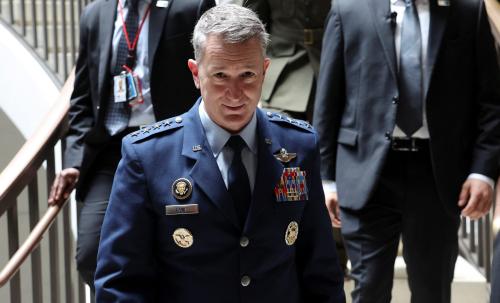* UPDATE: Michael O’Hanlon writes that the Army needs about 450,000 active-duty soldiers to meet potential future requirements.
U.S. Defense Secretary Chuck Hagel has proposed Pentagon budget cuts that could include reducing the size of the Army to between 440,000 and 450,000 troops, from a post-9/11 peak of nearly 570,000. Such a reduction would make the U.S. Army the smallest it has been since 1940.
Senior Fellow Michael O’Hanlon, who has written and commented extensively on military matters including specifically the size of the Army, told Stars and Stripes that “the Army cuts are about what has been expected for a long time” but “the bigger problem is what happens next—if there is sequestration, or deeper cuts?”
O’Hanlon participated in an event today, hosted by the Center for 21st Century Security and Intelligence, in which expert panelists—including two Army generals and a Marine Corps colonel—discussed the future of land warfare and ground forces.
Today’s news bulletins and the initial leaks on where the Quadrennial Defense Review and where the president’s new budget proposal may go are helping us create some obvious links to the importance of this issue. Because all of a sudden we’re hearing that the future of the U.S. Army in particular may be further curtailed, with the possibility of even deeper cuts depending on what happens to the budget in the next couple of years.
We also know that from two years ago the Pentagon put out a defense strategic guidance … that the future of land warfare is changing and that large scale stabilization missions of the type the nation has recently led in Iraq and Afghanistan are coming to an end. And we’ve essentially decided this as a matter of policy sitting here in our offices in Washington. And this raises interesting questions about whether we can really so shape the future of the world from the confines of places inside the Beltway or not. But more importantly, it raises the question of how does the Army, how does the U.S. Marine Corps, how do these organizations think about their future?
“Do we have any sense of what the Army is for? And what the Marine Corps is for, conceptually?” asked O’Hanlon at the event. “Are we deluding ourselves into thinking that these big, large missions can be declared to be over just because we’re tired of them?”
In November, O’Hanlon wrote specifically about the optimal Army size, noting a force size that is in the range that Secretary Hagel announced today:
The United States no longer needs to plan its main combat forces, and specifically its standing Army, around a scenario of two simultaneous all-out ground wars. And it can make cuts to the Army that will be somewhat larger than for the other services. But we must not go too far.
The Army should retain what I call a “1+2” paradigm for sizing forces: The capacity for one prompt, large-scale combat operation along with two midsize and longer-term multilateral stabilization missions. This approach would allow for an active-duty Army of 425,000 to 450,000 soldiers, down from 560,000 at the end of the George W. Bush presidency and the beginning of the Obama administration, a figure that is already gradually declining.
Full audio from today’s event is now available.
The first panel consisted of Major General William Hix and Major General Christopher Haas, both of the U.S. Army; Colonel Jim Zientek of the U.S. Marine Corps; and Brookings Senior Fellow
Peter W. Singer
. Major Generals Hix and Haas, and Colonel Zientek, served on a recent military task force created to develop strategic land power concepts for U.S. ground forces.
The event’s second panel included O’Hanlon; Commanding General of the Maneuver Center of Excellence Major General H.R. McMaster; and Brookings Senior Fellow William Galston who is also a retired U.S. Marine. They offered their unique perspectives on the future of land power.
The Brookings Institution is committed to quality, independence, and impact.
We are supported by a diverse array of funders. In line with our values and policies, each Brookings publication represents the sole views of its author(s).




Commentary
U.S. Army Cuts Must Not Go Too Far
February 24, 2014